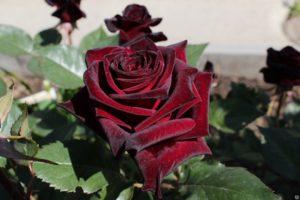Description and characteristics of a climbing rose of the Sympathy variety, planting and care
Climbing rose Sympathy is a tall plant that is decorated with bright and beautiful inflorescences. This culture has many virtues. It is actively used in landscape design to decorate arches, gazebos and other structures. To achieve lush and abundant flowering, it is necessary to properly care for the plant and provide it with protection from diseases and pests.
Description and characteristics of rose sympathy
The climbing rose of this variety is a perennial plant. This shrub is characterized by dark green leaves. The culture reaches 2.5-4 meters in height. The root system is considered to be sufficiently developed. The roots can be up to 2 meters long.
Sympathy is characterized by long and lush flowering. The first buds appear in mid-June. The culture fades in mid-October. The flowers are large and reach 10 centimeters. They are characterized by a rich red hue and terry petals. A distinctive feature of the culture is considered to be a sweet-spicy aroma. There can be 3-10 flowers on 1 stem.
Main pros and cons
This climbing plant has a number of advantages. These include the following:
- resistance to high humidity;
- resistance to low temperatures;
- resistance to dry weather;
- immunity to disease;
- long flowering period.
The disadvantages include the following:
- the need for shelter for the winter;
- the need for periodic rejuvenation of the bush;
- exactingness to the composition of the soil;
- susceptibility to proximity to weeds.
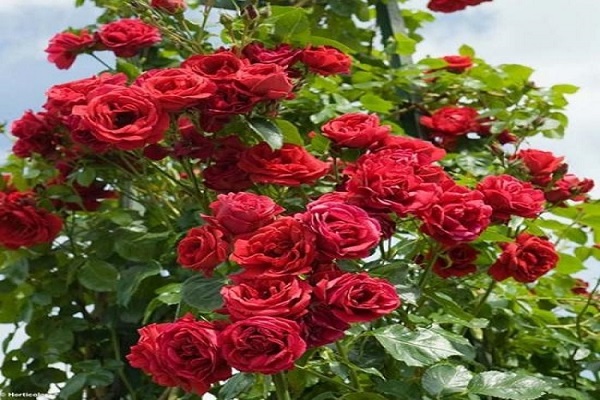
Cultivation rules of the variety
In order for the plant to grow normally and please with lush flowering, it is important to carry out planting work correctly.
When to plant?
The plant can be planted in spring or fall. Autumn planting is performed in the second half of September - before the onset of frost. In spring, the culture should be planted after the end of the cold period. This is usually done in late April or May.
Landing place
Rose Sympathy needs well-lit areas. It is important to provide the culture with quality protection from drafts. It is best to plant the plant on the east or south side of the site.
The culture is distinguished by its exactingness to the composition of the soil. It should be loose and fertile.

Clay soil is considered too heavy, and sandy soil is considered too soft. The best option for roses of this variety is loam.
Preparation of planting material
Before planting a plant, it must be carefully examined and get rid of dry or damaged roots. It is also worth trimming long shoots. As a result, 4-6 buds should remain on each of them. Selected seedlings are soaked in water or sodium humate for a day.
Scheme and depth
Planting requires 50 centimeters of pits. The bottom should be slightly loosened to get elevation. Place the seedling in the hole and distribute the roots so that they are located at an angle to the soil surface.
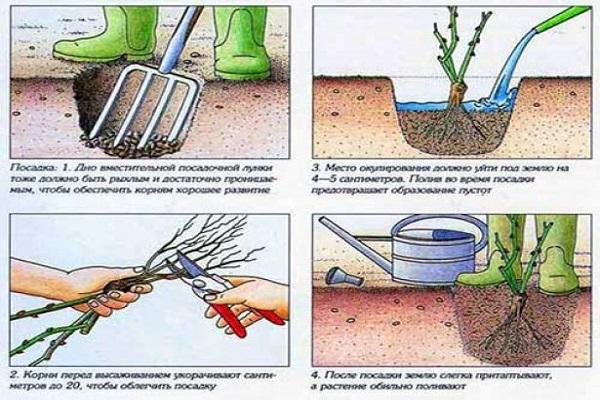
The root depth should be 12 centimeters. This provides reliable frost protection. After installing the seedlings, the hole should be sprinkled with soil so that there are no voids left. Then it is recommended to compact the top layer and make a small furrow for irrigation. Immediately after the completion of planting work, the soil should be watered abundantly.
Rose Care Tips
A rose of this variety is considered an unpretentious plant. It easily tolerates a drop in temperature and is resistant to adverse factors. However, a little maintenance is still required.
Watering and loosening
It is recommended to water the plant every 10-14 days. It is best to moisten the soil in the morning. For this it is worth using warm, settled water. Pour 3 buckets of water under an adult plant. After watering, the soil is loosened and mulched. This helps to retain moisture. For this, it is recommended to use humus or manure.
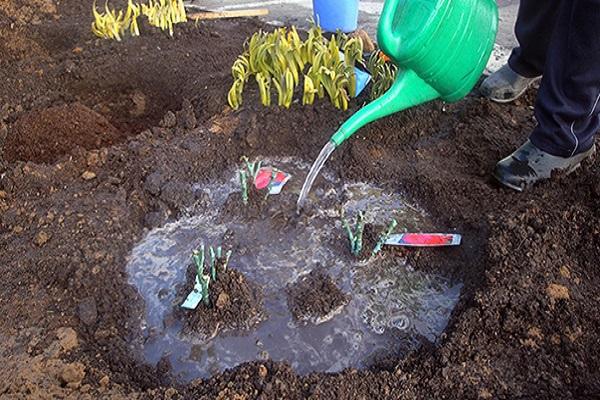
Top dressing and fertilization
It is worth applying mineral fertilizers 2 years after planting. For this, formulations for flowers are suitable. An excellent option would be the use of organic products. For this, it is recommended to mix manure with water in a ratio of 1:10. The mixture should be infused for 10 days, after which add another 10 parts of water and some ash. Feed the rose 2-3 times.
Garter and trim
The climbing culture needs to be tied up periodically. In spring, it is recommended to remove weakened and broken shoots. In the fall, it is worth removing branches that have faded. This helps to rejuvenate the bush.
A young plant needs to be formed. For biennial crops, it is recommended to leave up to 7 skeletal branches. The rest of the shoots are cut off. After 4 years, they should be replaced with younger ones. Subsequently, rejuvenation is carried out at intervals of 4-5 years.

Preparing for winter
Despite the plant's resistance to frost, it should be covered for the winter. In warm and dry weather, it is recommended to remove the lashes from the supports and cut off unnecessary branches. Tie up the remaining shoots and lay them on the ground. Sprinkle with leaves on top and cover with foil.
Protection against diseases and pests
The plant is susceptible to powdery mildew. In this case, white spots appear on the leaves. To cope with the disease, the bushes are sprayed with Bordeaux liquid.
Symptoms of black spot may also appear on the leaves. A solution of ferrous sulfate helps to cope with the disease. In rainy weather, there is a risk of gray rot. In such a situation, all affected shoots are cut off.

Sometimes the plant encounters bark cancer. For treatment, diseased areas must be cut off and burned. For prevention, it is recommended to introduce potassium preparations.
Of the pests, the rose is susceptible to attacks by aphids and spider mites. To prevent the appearance of parasites, the bushes are watered with a decoction of nettle. When symptoms of infection appear, insecticides have to be used.
Breeding methods
Most often, the plant is propagated by cuttings. For this, shoots with 4-5 buds are used. It is worth planting a crop in early June.
It is also permissible to reproduce the rose by layering. To do this, it is recommended to press the lash to the ground, spud and water. Once the roots appear, the plant can be cut off and transplanted.
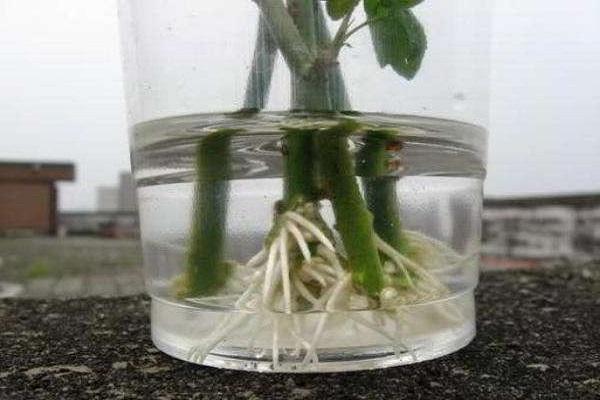
Another method is dividing the bush.For this, an adult plant should be divided into 2 parts.
Each piece should contain roots and stems.
Application in landscape design
This climbing plant is actively used to decorate fences, arches, arbors. The rose can be combined with small architectural structures. It is also permissible to tie the whips to the horizontal bars.
Rose Sympathy is a wonderful ornamental plant, which is very popular among flower growers. To succeed in growing a crop, you need to provide it with proper care.

